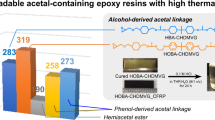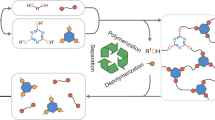Abstract
Thermoset materials containing about 70 wt% epoxy resin are widely used in critical aerospace and wind power structures, generating enormous amounts of waste (such as offcuts and damaged, worn and disposed parts) that affect both the environment and the sustainable development of human society. Owing to their irreversible crosslinked networks, thermoset materials pose major challenges for rapid degradation and high-efficiency recycling. Here we report the synthesis of thermoset hyperbranched polymers (HER-HTn) containing a reversible heterocyclic structure (hexahydro-s-triazine) that can be degraded under relatively mild conditions. The cured HER-HTn exhibit excellent mechanical and thermal properties, as well as rapid degradability in more environmentally friendly phosphoric acid solutions. Controlled degradation experiments show that the cured HER-HTn can be completely digested at relatively low temperatures (90 °C) in a short period (2 h) to recover 2-aminobenzyl alcohol at a high recycling efficiency (85.1%). The recovered 2-aminobenzyl alcohol can then be used to produce the initial hexahydro-s-triazine monomer, which demonstrates the reversibility of the hexahydro-s-triazine structure and recoverability of the thermoset hyperbranched polymers. This investigation provides a method for the synthesis of a degradable thermoset matrix and the cyclic use of high-value materials in the thermoset and its composites.
This is a preview of subscription content, access via your institution
Access options
Access Nature and 54 other Nature Portfolio journals
Get Nature+, our best-value online-access subscription
$29.99 / 30 days
cancel any time
Subscribe to this journal
Receive 12 digital issues and online access to articles
$119.00 per year
only $9.92 per issue
Buy this article
- Purchase on Springer Link
- Instant access to full article PDF
Prices may be subject to local taxes which are calculated during checkout




Similar content being viewed by others
References
Rohde, B. J., Le, K. M., Krishnamoorti, R. & Robertson, M. L. Thermoset blends of an epoxy resin and polydicyclopentadiene. Macromolecules 49, 8960–8970 (2016).
Chen, S., Zhang, J., Zhou, J., Zhang, D. & Zhang, A. Dramatic toughness enhancement of benzoxazine/epoxy thermosets with a novel hyperbranched polymeric ionic liquid. Chem. Eng. J. 334, 1371–1382 (2018).
Zhang, D. et al. Highly efficient preparation of hyperbranched epoxy resins by UV-initiated thiol-ene click reaction. Prog. Org. Coat. 101, 178–185 (2016).
Liu, T. et al. Environmentally friendly high performance homopolymerized epoxy using hyperbranched epoxy as a modifier. RSC Adv. 6, 14211–14221 (2016).
Xu, P., Li, J. & Ding, J. Chemical recycling of carbon fibre/epoxy composites in a mixed solution of peroxide hydrogen and N,N-dimethylformamide. Compos. Sci. Technol. 82, 54–59 (2013).
Chruściel, J. J. & Leśniak, E. Modification of epoxy resins with functional silanes, polysiloxanes, silsesquioxanes, silica and silicates. Prog. Polym. Sci. 41, 67–121 (2015).
Zhang, D. et al. The effect of molecular weight of hyperbranched epoxy resins with a silicone skeleton on performance. RSC Adv. 3, 9522–9529 (2013).
Huang, Y., Wang, D., Zhu, X., Yan, D. & Chen, R. Synthesis and therapeutic applications of biocompatible or biodegradable hyperbranched polymers. Polym. Chem. 6, 2794–2812 (2015).
Jiang, G., Pickering, S. J., Lester, E. H. & Warrior, N. A. Decomposition of epoxy resin in supercritical isopropanol. Ind. Eng. Chem. Res. 49, 4535–4541 (2010).
García, J. M. et al. Recyclable, strong thermosets and organogels via paraformaldehyde condensation with diamines. Science 344, 732–735 (2014).
Montarnal, D., Capelot, M., Tournilhac, F. & Leibler, L. Silica-like malleable materials from permanent organic networks. Science 334, 965–968 (2011).
Yuan, Y. et al. Multiply fully recyclable carbon fibre reinforced heat-resistant covalent thermosetting advanced composites. Nat. Commun. 8, 14657 (2017).
Zhang, Y., Broekhuis, A. A. & Picchioni, F. Thermally self-healing polymeric materials: the next step to recycling thermoset polymers? Macromolecules 42, 1906–1912 (2009).
Ma, S. et al. Bio-based epoxy resin from itaconic acid and its thermosets cured with anhydride and comonomers. Green Chem. 15, 245–254 (2013).
Nikafshar, S. et al. A renewable bio-based epoxy resin with improved mechanical performance that can compete with DGEBA. RSC Adv. 7, 8694–8701 (2017).
Palmer, J., Ghita, O. R., Savage, L. & Evans, K. E. Successful closed-loop recycling of thermoset composites. Compos. Pt A 40, 490–498 (2009).
Yu, K., Shi, Q., Dunn, M. L., Wang, T. & Qi, H. J. Carbon fiber reinforced thermoset composite with near 100% recyclability. Adv. Funct. Mater. 26, 6098–6106 (2016).
Yang, P., Zhou, Q., Yuan, X. X., Kasteren, J. M. N. V. & Wang, Y. Z. Highly efficient solvolysis of epoxy resin using poly(ethylene glycol)/NaOH systems. Polym. Degrad. Stab. 97, 1101–1106 (2012).
Wang, Y. et al. Chemical recycling of carbon fiber reinforced epoxy resin composites via selective cleavage of the carbon-nitrogen bond. ACS Sustain. Chem. Eng. 3, 3332–3337 (2015).
La Rosa, A. D., Banatao, D. R., Pastine, S. J., Latteri, A. & Cicala, G. Recycling treatment of carbon fibre/epoxy composites: materials recovery and characterization and environmental impacts through life cycle assessment. Compos. Pt B 104, 17–25 (2016).
Cicala, G., Pergolizzi, E., Piscopo, F., Carbone, D. & Recca, G. Hybrid composites manufactured by resin infusion with a fully recyclable bioepoxy resin. Compos. Pt B 132, 69–76 (2018).
Hazarika, D. & Karak, N. Waterborne sustainable tough hyperbranched aliphatic polyester thermosets. ACS Sustain. Chem. Eng. 3, 2458–2468 (2015).
Overcash, M., Twomey, J., Asmatulu, E., Vozzola, E. & Griffing, E. Thermoset composite recycling—driving forces, development, and evolution of new opportunities. J. Compos. Mater. 52, 1033–1043 (2018).
Wang, L. et al. Synthesis of recyclable hyperbranched polymers with high efficiency of promoting degradation of epoxy resins. ChemistrySelect 3, 4873–4883 (2018).
Chen, S., Xu, Z. & Zhang, D. Synthesis and application of epoxy-ended hyperbranched polymers. Chem. Eng. J. 343, 283–302 (2018).
Hashimoto, T. et al. Degradable and chemically recyclable epoxy resins containing acetal linkages: synthesis, properties, and application for carbon fiber-reinforced plastics. J. Polym. Sci. Pt A 50, 3674–3681 (2012).
Luzuriaga, A. R. D. et al. Epoxy resin with exchangeable disulfide crosslinks to obtain reprocessable, repairable and recyclable fiber-reinforced thermoset composites. Mater. Horiz. 3, 241–247 (2016).
Johnson, L. M. et al. Controlled degradation of disulfide-based epoxy thermosets for extreme environments. Polymer 64, 84–92 (2015).
Taynton, P. et al. Repairable woven carbon fiber composites with full recyclability enabled by malleable polyimine networks. Adv. Mater. 28, 2904–2909 (2016).
Sims, M. B., Patel, K. Y., Bhatta, M., Mukherjee, S. & Sumerlin, B. S. Harnessing imine diversity to tune hyperbranched polymer degradation. Macromolecules 51, 356–363 (2018).
You, S. et al. Hexahydro-s-triazine: a trial for acid-degradable epoxy resins with high performance. ACS Sustain. Chem. Eng. 5, 4683–4689 (2017).
Wojtecki, R. J. et al. Development of a method for detecting trace metals in aqueous solutions based on the coordination chemistry of hexahydrotriazines. Analyst 140, 5184–5189 (2015).
Pickering, S. J. Recycling technologies for thermoset composite materials—current status. Compos. Pt A 37, 1206–1215 (2006).
Yu, Q. et al. Synthesis of a degradable high-performance epoxy-ended hyperbranched polyester. ACS Omega 2, 1350–1359 (2017).
Zhang, D. & Jia, D. Toughness and strength improvement of diglycidyl ether of bisphenol-A by low viscosity liquid hyperbranched epoxy resin. J. Appl. Polym. Sci. 101, 2504–2511 (2006).
Deng, J., Liu, X., Li, C., Jiang, Y. & Zhu, J. Synthesis and properties of a bio-based epoxy resin from 2,5-furandicarboxylic acid (FDCA). RSC Adv. 5, 15930–15939 (2015).
Gao, M. & Yang, S. A novel intumescent flame-retardant epoxy resins system. J. Appl. Polym. Sci. 115, 2346–2351 (2010).
Li, C., Wang, Q. & Zhao, Z. K. Acid in ionic liquid: an efficient system for hydrolysis of lignocellulose. Green Chem. 10, 177–182 (2008).
Ma, H., Feng, X. & Zeng, B. Self-anticorrosion for the combustion tower of heat recovered thermal process phosphoric acid production. Process Saf. Environ. Prot. 118, 330–347 (2018).
Wu, T. et al. Phosphoric acid-based preparing of chitin nanofibers and nanospheres. Cellulose 23, 477–491 (2016).
Yu, K., Taynton, P., Zhang, W., Dunn, M. L. & Qi, H. J. Influence of stoichiometry on the glass transition and bond exchange reactions in epoxy thermoset polymers. RSC Adv. 4, 48682–48690 (2014).
Scott, Howard R. & Scott, Lillian E. Process of treating nut kernels to produce food ingredients. US patent 1,416,128 (1920).
Alfieri, A. et al. Effects of plant oil interesterified triacylglycerols on lipemia and human health. Int. J. Mol. Sci. 19, E104 (2017).
Acknowledgements
We acknowledge financial support from the National Natural Science Foundation of China (grant nos. 51573210 and 51873233), Hubei Province Natural Science Foundation (grant no. 2018CFA023) and Hubei Province Fund for Major Technological Innovation Projects (grant no. 2017AAA131).
Author information
Authors and Affiliations
Contributions
Z.X., D.Z. and M.M. conceived and designed the experiments. Y.L. and X.M. performed the experiments. Z.X., S.C. and C.Y. analysed the data. Y.W. contributed the materials and analysis tools. Z.X., D.Z. and M.M. wrote and revised the paper. All authors participated in discussions and reviewed the manuscript.
Corresponding author
Ethics declarations
Competing interests
The authors declare no competing interests.
Additional information
Publisher’s note Springer Nature remains neutral with regard to jurisdictional claims in published maps and institutional affiliations.
Supplementary information
Supplementary Information
Supplementary Figs. 1–9, Tables 1–5, Notes 1–3, methods and references.
Source data
Source Data Fig. 2
Source Data
Source Data Fig. 4
Source Data
Rights and permissions
About this article
Cite this article
Xu, Z., Liang, Y., Ma, X. et al. Recyclable thermoset hyperbranched polymers containing reversible hexahydro-s-triazine. Nat Sustain 3, 29–34 (2020). https://doi.org/10.1038/s41893-019-0444-6
Received:
Accepted:
Published:
Issue Date:
DOI: https://doi.org/10.1038/s41893-019-0444-6
This article is cited by
-
Reprocessable and ultratough epoxy thermosetting plastic
Nature Sustainability (2024)
-
A comparative machinability analysis of polyimine vitrimer, epoxy and polycarbonate polymers through orthogonal machining experiments
The International Journal of Advanced Manufacturing Technology (2024)
-
Vanillin-based degradable thermosets with superior dielectric properties via regulation of imine cross-linked structure
Journal of Materials Science (2024)
-
High-Performance Recyclable Furan-based Epoxy Resin and Its Carbon Fiber Composites with Dense Hydrogen Bonding
Chinese Journal of Polymer Science (2024)
-
Thermal cure kinetics of highly branched polyurea resins at different molar ratios
Journal of Thermal Analysis and Calorimetry (2023)



